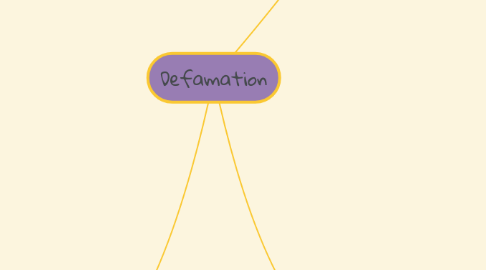
1. tends to lower people's reputation in estimation of right minded person and tend to course him to be avoided
1.1. Normala shamsuddin v keluarga communication
1.2. Syed Hussin Ali v Sharikat Perchetakan Utusan Melayu; defamation need no actual effect on person's reputation -- needs only tendecy
2. Defences
2.1. JUSTIFICATION
2.1.1. Absolute defences
2.1.2. state of mind of party is irrelevant
2.1.3. Sect 8 Defamation Act; Need not proof all truth of all allegatiion
2.1.3.1. Voon Lee Shan v Sarawak Press.
2.1.4. Malice does not defeat this defences
2.1.5. Except:
2.1.5.1. Allegation about criminal offences because;
2.1.5.2. contradict justice system
2.1.5.3. harmful effect to plaintiff.
2.1.6. S Pakianathan v Dr Jeni Ibrahim
2.2. FAIR COMMENT
2.2.1. Sect 9 Defamation Act
2.2.1.1. Words are in form of fair comment not statement of fact
2.2.1.2. Comment is based on true fact
2.2.2. CONDITIONS:
2.2.2.1. Words in form of comment, not statement of fact
2.2.2.1.1. Meeran Labbaik v Mohamad Ismail Merican
2.2.2.2. Comment given is based on true fact
2.2.2.2.1. Mohd Jali Ngah v Newstraight times press
2.2.2.3. Comment not malicious
2.2.2.4. comment concern public interest
2.2.2.4.1. Pusaka Delta Pelayaran Sdn Bhd v Berita Harian.
2.3. CONSENT DEFAMATION
2.3.1. p gives consent for publication/ express it impliedly
2.3.2. Cookson v Harewood
2.4. APOLOGY
2.4.1. Sect 10 Defamation Act
2.4.2. Advisable for def to make prompt apology when there is no defenses that can be used
2.4.3. Reduce damage rewarded
2.4.4. Can be done before of after proceedings.
2.5. UNINTENTIONAL DEFAMATION
2.5.1. Sect 7 Defamation Act
2.5.2. offer of amendment can be made
2.5.3. Sandison v Malayan Times
2.6. INNOCENT DISSEMINATION
2.6.1. Mere distributor not subject to suit.
2.6.2. it would impose undue hardship to mere distributor
2.6.3. Vizetelly v Mudie's Secret ltd.
2.6.3.1. Must prove:
2.6.3.1.1. He did not have knowledge that the publication contains libel
2.6.3.1.2. There was no circumstances that come to him showing that there was libel
2.6.3.1.3. publication was not caused by his negligences.
3. Types of Defamation
3.1. Libel
3.1.1. Permanent form,
3.1.2. Actionable per se
3.1.3. sect 499 penal code
3.1.4. There is no libel by ommision (no one can sue for omitting extra words.
3.1.5. Elements
3.1.5.1. Words are defamatory
3.1.5.1.1. Natural and ordinary meaning
3.1.5.1.2. Innuendo
3.1.5.1.3. Juxtaposition
3.1.5.1.4. does not matter that no one believed in to be true
3.1.5.1.5. not uttered in heated moment
3.1.5.1.6. intention is irrelevant
3.1.5.1.7. not necessarily representation of majority opinion in society
3.1.5.1.8. LAU CHEE KUAN V CHOW SOONG SEONG
3.1.5.2. Words refer to plaintiff
3.1.5.2.1. Statement made was direct to plaintiff.
3.1.5.2.2. Intention not relevant.
3.1.5.2.3. need not be identified by name.
3.1.5.2.4. TEST:
3.1.5.2.5. Sandison v Malaya Tiimes
3.1.5.2.6. Morgan v Odham Press
3.1.5.2.7. Hulton v Jons
3.1.5.2.8. Newstead v London Newspaper
3.1.5.3. Words are published
3.1.5.3.1. Word is published.
3.1.5.3.2. Can be in many form
3.1.5.3.3. defendant can be more than 1
3.1.5.3.4. Theaker v Richardson
3.1.5.3.5. Huth v Huth
3.1.5.3.6. Except:
3.2. Slander
3.2.1. Not permanent/spoken word--gestures
3.2.2. GR: Not actionable per se
3.2.2.1. Except:
3.2.2.1.1. imputation of criminal offences punishable by death
3.2.2.1.2. imputation of contagious diseases
3.2.2.1.3. imputation of chasity of women
3.2.2.1.4. imputation of dishonesty/ incompetence in respected professionalism
3.2.3. not a criminal offences.

